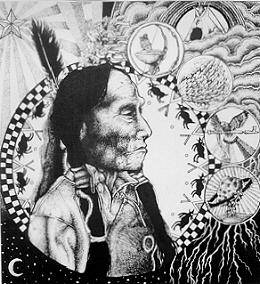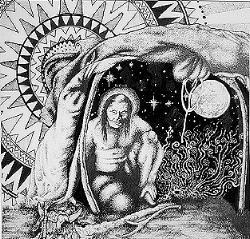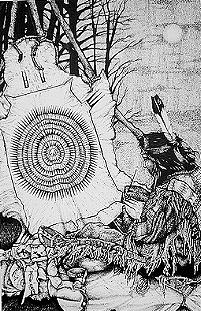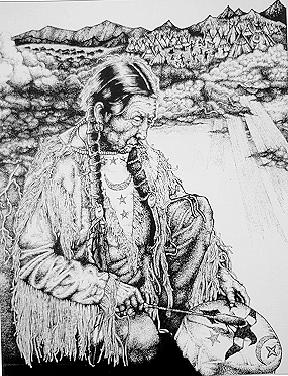ANDY KNERR
Andy Knerr was born in Michigan, but has claimed the foothills of North Carolina as his home for the past 12 years. Growing up on the "coast" of Lake Michigan gave Andy many opportunities to learn about the tribes of The Great Lakes region, especially the chance to attend his first "pow-wows".
Showing artistic promise at an early age, he won scholarships to attend The Kalamazoo Art Institute. Andy went on to become the youngest artist to take life-drawing classes in the history of the Institute. After graduating from high school, he moved south to attend The Atlanta College of Art at the prestigious Robert Woodruff Center. Andy felt that he learned more by looking at other artist's works, and he left as soon as he acquired his B.F.A.
After school, Andy used his talents to travel and meet different people. From painting Harley Davidson motorcycles to creating tattoo and musical band designs, he was exposed to many different ideas and perceptions. Andy continued to pursue his interests in Native American culture in private, and avoided commercial recognition until his father advised him to try it out. When his father died 6 months later, Andy decided to devote his life and art to capturing the beauty and detail of the culture of Native Peoples`.
During the summer Andy and his wife, Michelle, follow the pow-wow "circuit". During winter he shows his work in galleries, and gives lectures on the culture of the plains tribes. He recently was asked to do a one-man show at The Flour Daniel Corporate Building. He has been published in both national and international magazines. His pen and ink works are popular for the detail and careful attention paid to keeping each piece traditionally correct.
Andy believes that it is time to break the romantic (but misguided) stereotypes that keep Native Americans in the past with the "old west". He often uses traditional themes but many of the models are alive (some are friends). Andy wants the world to know that these tribes are still with us, some flourishing economically. They have much to offer, and even if some of their ideas seem primitive in today's world of technology, they may hold our hopes to keep our most precious resource: our planet Earth.
One Artist's Journey into the Spirit
"I'm not trying to promote the idea of the noble savage", explains artist Andy Knerr, whose pen and ink drawings depict many aspects of Native American history and current events. "I don't want to forget the beauty, because that is what I set out to capture - beauty in the details of their regalia, and the lines of their faces. Indians are still here. It's not an old movie myth".
Along with his wife Michelle Andy has called the Greenville area of South Carolina home for the past twelve years. The artist's early life in Kalamazoo, Michigan fostered a love for Native American Culture, particularly the plains tribes. This infatuation has stayed with Knerr throughout many hard times and risky decisions, ultimately leading to an intensive focus in the area of visual art.
"I grew up with a grandfather and father who knew a lot about many different tribes", elaborates Knerr. "One of the first things I remember is my grandfather giving me a hand-painted deer skin with authentic arrows tied to it with deer string. I was led to believe early on in life that I did have Navajo blood , but a lot of Navajo refer to themselves as dineh, which basically means human being". Knerr adds that he does not claim allegiance to one particular tribe, although questions about his Native American heritage are often the first he hears from people interested in his art.
"I am not doing pieces that focus on Native Americans, because I want to be one, or feel that it's a place where I belong", says Knerr. "I am doing it to show how they see things in different ways. They are willing to open up their minds, and even if they don't believe in what somebody is doing, love them anyway. That is the kind of thinking we need more of. I am interested in Indian culture, because they have completely different perceptions of this world - and if more people could learn that you can take these perceptions and use them -then it isn't too late".
Using his extensive knowledge of tribal traditions and drawing from the creative energy of contemporary Native American Artists, Knerr presents visual stories in pen and ink. The finished pieces are as much oral tradition as they are visual, living history. Symbols and daily rituals combine to show viewers a world that is very much alive rather than an Old West myth.
"Everybody wants to think in terms of Dances with Wolves", says Knerr. "And a lot of people don't want to deal with Indian imagery - it makes them sad. I think it is sad not to take time to look around and see how the tribes are flourishing".
If his latest work is any indication - Knerr has found the medicine he needs to live in harmony with the Earth and his creative calling. His new series of four signed and numbered prints detail different facets of Native American culture and life:
"The Story of the Ghost Dance", "The Inipi Ceremony (or Sweatlodge)", "Black Elk's Vision", and "Winter Count".
All prints are available in LIMITED Editions.
(payments are accepted in US-$, German Marks, and Pound Sterling)
A new series will shortly be available in limited edition prints, of which two - "BLACKFOOT HOLY MAN" and "JAMES HOLY EAGLE" will also be available on T-Shirts and Sweatshirts.
Andy is also available for lecture tours, information on Pow-Wows, Native American History, Rituals & Ceremonies, Literature recommendations, etc. Andy will gladly answer all questions related to the Native Americans. All inquiries may be directed to Bridget Jordan at above E-mail address or by Mail to:
Inquiries in German language are welcome.
Interessenten steht Andy gerne Rede und Antwort - Anfragen können auch in Deutsch an o.a. Adresse oder EMail gerichtet werden. |



 "Wanagi Wacipi", or "The Story Of The Ghost Dance"
"Wanagi Wacipi", or "The Story Of The Ghost Dance"